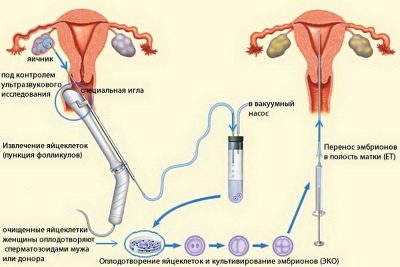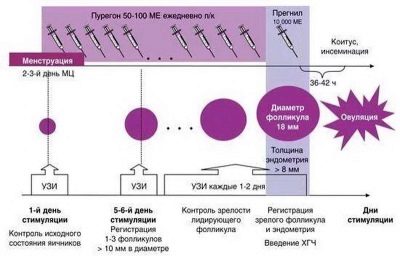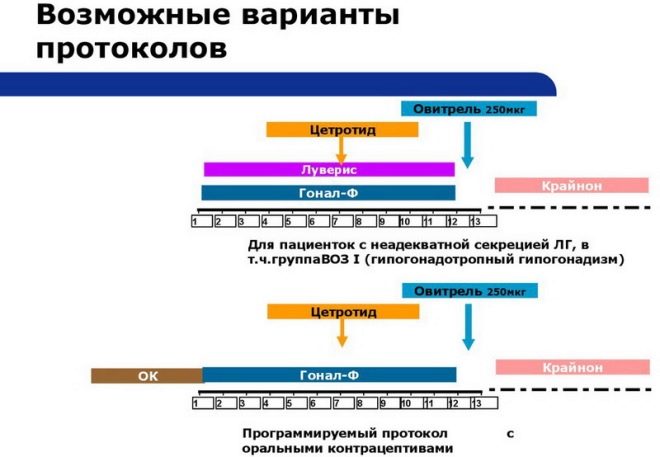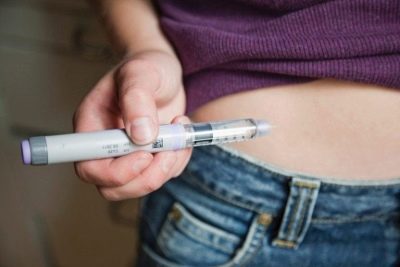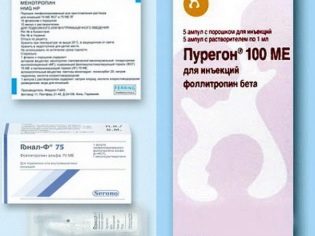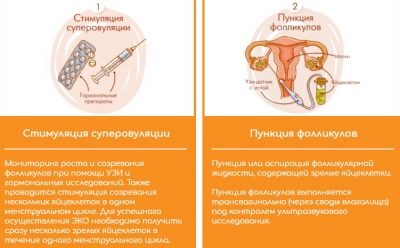What is an IVF protocol: types, patterns and features
A woman who will have IVF will have to learn new terms and concepts for her, which reproduction specialists will generously “pour” during the entire course of treatment. The patient will be more comfortable and calm if she learns to understand this "medical language". In this article we will describe in detail what the IVF protocol is and what types of it are used to combat the problem of infertility.
Concept and features
The IVF protocol is an individual treatment regimen for a particular woman. The main stages of in vitro fertilization are consistently for everyone, but the features of the approach, the choice of medications, the beginning and end of hormone therapy for each woman are individual.
The start of treatment is called entry into the protocol. This happens after the couple undergoes a thorough medical examination and agreement on the procedure of in vitro fertilization and the contract for the provision of assisted reproductive health services will be signed.
Different protocols differ only in their initial stage. The goal of any kind of one - to get as much as possible full, healthy, suitable for fertilization outside the body of a woman's eggs. To do this, doctors use different hormones. Hormones stimulate the growth of follicles and in the ovaries of a woman who enters the IVF protocol, not one egg matures (as it happens during the normal menstrual cycle of each fair sex), but several oocytes at the same time.
When the follicles mature, the doctors perform a procedure for puncturing the ovaries, and they produce eggs. After that, the procedure for all patients will be approximately the same - the oocytes fertilize with the husband’s sperm, donor sperm or ICSI, the embryos are grown and observed for several days, after which a certain amount is transferred to the uterine cavity of the woman. On embryo transfer, the IVF protocol officially ends.
After 2 weeks, usually the woman is completely in the dark, and only 14 days after the transfer, she can donate blood for hCG, and 21 days after embryos transfer, ultrasound can confirm that the pregnancy has begun (or has not started).
Thus, the protocol differences are in the method, duration, and method of stimulating a woman's ovaries to obtain oocytes. The more of them will be received, the higher will be the chances of a successful IVF protocol, which will bring happiness to motherhood.
Classification
Immediately it should be noted that the woman does not have the right to choose the type of protocol. It can only be chosen by a doctor-reproductologist, who will carefully examine the finished tests, the ultrasound results, the spermogram of her husband. The age of the patient, the type of her physique, the presence of diseases of the reproductive organs (especially the ovaries), as well as the results of analyzes for the hormonal profile will also be taken into account.
There are two large groups of protocols:
- stimulated;
- in the natural cycle.
Stimulated is a protocol in which doctors stimulate the ovaries to work with hormonal drugs to obtain the maximum number of eggs. In the natural cycle, women are not stimulated; they are content with only one (extremely rarely two) egg, which can be obtained in the course of natural processes in the menstrual cycle.
The protocol in the natural cycle has no subspecies, whereas there are quite a lot of stimulated protocols. Most often, IVF is used specifically for the stimulated protocol, since its effectiveness is much higher than in the treatment of infertility in the natural cycle.
Although with natural IVF without hormones, a woman receives significantly less harmful effects on her body.
Stimulated schemes can be:
- short;
- long.
With short protocols, the doses of hormonal drugs are lower, and the duration of their administration is less. With a long protocol (recommended with poor quality of the eggs, with a small number of them, hormonal infertility), the use of stimulating drugs is longer. The risk of complications and negative consequences for the woman’s body is higher with a long protocol, but sometimes this is the only way to make a woman a happy mother.
In the process of any of the types of women are encouraged to keep diaries and fill out questionnaires in which the doctor will be able to note the individual reactions of the female body to treatment. In the course of any stimulated protocol, the patient must repeatedly visit a fertility specialist, who will do an ovarian ultrasound to evaluate their response and count growing follicles.
Schemes may change if there is an inadequate response of the female sex glands to stimulation. At any stage, the doctor may change the dosage, frequency and even the drug itself to another.
In addition to the above main types, there are also other protocols that usually do not distinguish into separate classification groups, but which are used quite often:
- Ultra long - protocol designed for a long time. All substances are administered in doses that allow hormones to act slowly.
- Long antagonist hormone protocols - These are schemes in which stimulants are first used, and then drugs that will “hold back” the follicles in order to prevent spontaneous ovulation (antagonists). Suitable for women with a small ovarian reserve.
- Protocols with Diferelin - schemes in which the specified drug is used (for women with an increased risk of developing ovarian hyperstimulation syndrome).
- French protocol - the variant of the long protocol differs from the standard scheme by days and differs by minimal stimulation.
- Modified - protocol variant in the natural cycle, with minimal single stimulation of the mature follicle before puncture.
- Japanese - A method with minimal hormonal stimulation, in which the first place is not the number of oocytes, but their quality.
- Shanghai (Chinese) - a scheme in which for a single cycle a woman takes an egg twice, double stimulation turns out, embryo transfer is postponed until later.
As already mentioned, the difference between different protocols lies not only in the intensity of the use of hormonal drugs, but also in the duration of treatment. Here are the average values of the duration of each species:
- Ultrashort protocol. Stimulation of 8-10 days, the total duration of the IVF program - 25-30 days.
- Short protocol. The total duration of treatment is from 28 to 36 days, the stage of ovarian stimulation is from 10 to 17 days.
- Long protocol. The total duration of the treatment course is 40-50 days, the stage of superovulation stimulation is 21-28 days.
- Super long protocol. The total duration is 50 days + several months, which are required for preliminary hormonal correction of individual gynecological and metabolic problems. Stimulation of ovulation lasts 3-4 weeks.
- Modified. Total duration - 25-30 days, stimulation - 1 day.
Below we consider in detail each of the subtypes of the long and short protocols, so that the woman they are coming will have a good idea of the procedure and possible consequences of treatment.
General rules
For any of the types of IVF protocols, the general rules that a woman must adhere to in order to maximize the effectiveness of treatment are relevant. First of all, you need to know that 99% of the drugs prescribed by the doctor belong to the category of injectables. This means that you need to do injections - subcutaneously or intramuscularly (depending on the destination).
Women are allowed to do the injections themselves, because every day they visit the clinic in order to get another injection, the majority have no physical ability. All subcutaneous drugs are injected into the stomach, all intramuscular - buttocks.
A woman should strictly adhere to the conditions of the protocol, observing the dosage and frequency of administration. It is important to make shots every day at the same time without delay.
You can not skip the ultrasound control, which is prescribed several times per protocol. The hormone dose may be reduced or increased depending on the ovarian response. Normally, follicles should grow by 2 mm per day, and the functional layer of the uterus (endometrium), which is preparing for the implantation of the ovum, must "grow up" by 1 mm per day. If growth rates are excessive, the dosage is reduced; if insufficient, it increases. Categorically you can not arbitrarily change the dose or drug.
Before puncture of the ovaries, regardless of the type of protocol, all women are given the so-called ovulation triggers. These are substances that help ovules to ripen 36 hours after drug administration. Oocytes must detach from the walls of the follicles and freely “float” inside the follicles in the follicular fluid. Then they will be easy to get during puncture. Usually in the Russian clinics for this purpose use drugs "Ovitrel" and "Pregnil".
During a stimulated protocol, a woman may notice various changes in her state of health - weight gain, dizziness, nausea, vomiting, gas flaring in the intestines, headaches, irritability, tearfulness and spontaneous mood changes. A record of this must be made in the diary of the woman planning the pregnancy and at the reception it is necessary to report this to the doctor.
With a strong protest reaction of the body to stimulation, it is the physician who must decide how to change the protocol, what type to choose in the future, so that the woman can still get pregnant and give birth to a healthy baby. Trust your doctor.
A long
This is the most common type of treatment regimen in Russia. Entry into a long protocol must always be medically justified. This type of treatment is suitable for women with serious disorders of the endometrium, with pathological processes in the ovaries (for example, in the presence of cysts). It is well suited for middle-aged women, whose ovarian reserve is rated as average. If the quality of the oocytes is poor, as the previous unsuccessful IVF attempt showed, doctors usually prefer the long scheme for the second attempt.
The undoubted advantages of any long scheme are the simultaneous maturation of the follicles, approximately the same size as well as a large number of oocytes (up to 20 eggs can be obtained!). Immature oocytes in the material “harvested” by doctors during the puncture are much less.
The disadvantages are a serious hormonal load on the female body, an increased risk of ovarian hyperstimulation syndrome, their subsequent exhaustion, as well as patient complaints about poor health in the implementation of the protocol.
Usually, a long protocol starts from 21-22 days of the menstrual cycle, that is, you need to enter into the protocol about two weeks before the start of the next scheduled menstruation. Within two weeks, hormonal drugs such as "Diferelin", "Decapeptil", "Orgalutran", "Regulon" are administered to the woman. They must prepare the ovaries for the upcoming follicle-stimulating preparation.Menstruation begins, and already on day 3 of the new cycle, it is recommended that the woman begin to introduce other hormones that will stimulate the growth of follicles - FSH, Puregon, Gonal-F, Menopur. The duration of treatment is on average from 10 to 14 days.
After a single injection of hCG preparations, when the follicles reach sizes from 16–17 to 20–22 mm, after 36 hours, the procedure for collecting eggs is prescribed.
With the super-long protocol, “Decapeptil” or “Orgutran” will be administered not for several days in a row, but for one injection per month for half a year. In this case, the hormonal substance will not strongly affect the woman, it will be soft and gradual. This is very important for women who have uterine fibroids, as well as ovarian cysts, including those arising from previous protocols. The doctor will proceed to direct stimulation only when he sees that the fibroid has decreased, and the cysts have resolved.
In a long protocol with antagonists, a woman with a meager ovarian reserve (for example, a woman after 40 years) can find the happiness of motherhood. With him, from 21-23 days of the cycle, a woman begins to block her with hormones that cause the state of artificial menopause, suppress the ovaries (“Metipred”). The blockade lasts from 12 to 20 days. Then, from the 3rd day of the menstrual cycle, the ovaries are stimulated for two weeks. This time is usually quite enough to start ovulation. Then prescribe a puncture.
After the transfer, on the very first day, they switch to progesterone support of the corpus luteum with such drugs as Duphaston, Urozhestan, Proginova.
The disadvantage of this protocol lies in the fact that a woman at the blockade stage can experience all the symptoms of menopause, it is difficult to tolerate therapy. Long protocols with antagonists are morally difficult, because the mood with aggressive hormonal effects is rarely positive and optimistic. The advantages are that the doctor receives all the “access codes” to the female body, since all the hormonal processes in the reproductive system are controlled by artificial hormones - increasing and decreasing the dosage, and therefore, the probability of IVF success is higher.
Short
With a short protocol, the regulating phase is absent in principle. Immediately begins the stimulating phase. Beginning - 3-5 days of the menstrual cycle. On the first day of stimulation, follicle-stimulating hormones (FSH) will do. It lasts up to 17 days, the puncture of the follicles after the preliminary injection of hCG takes about 20 days of the cycle.
The advantage of such a scheme is in the absence of large doses of hormones, which is more beneficial for the female body. The probability of ovarian hyperstimulation and other unpleasant manifestations of the effects of the hormones listed above is significantly reduced. The downside is that a much smaller number of eggs can be obtained in the short protocol, and their quality can be better.
Short protocols are recommended for women with sufficient or rich ovarian reserve. It is suitable for "age-related" women, as well as all those who have ovarian function with the existing problem of infertility are fully preserved. Often, a short protocol conducted after an unsuccessful long increases the likelihood of pregnancy.
The Japanese protocol (Theramoto scheme) minimizes hormonal effects, limited only by the introduction of preparations for the maturation of the egg. After receiving the embryos, they are usually frozen in order to carry out a cryoprotocol in the future (infusion of thawed embryos).
Double stimulation
The so-called Duostim protocol (Chinese protocol). It is a double stimulation. For 2-3 days of the menstrual cycle, the woman begins and passes the standard 10-14-day stimulation of superovulation, after collecting the eggs after 2-3 days, she is followed by stimulating therapy and again puncture follicles. The transfer of the resulting embryos is transferred to the following cycles.
This method of overcoming infertility is more suitable for women with a poor egg reserve. Often, this protocol is chosen for women over 40 who are planning to carry out an additional IVF step - pre-implantation diagnosis.
By the way, the protocol in which the production of oocytes occurs in one cycle, and the replanting in another, is called a segmented protocol. Women may also encounter this term in preparation for artificial insemination.
Recommendations
Before entering into any of the ECO protocols, a woman should take all measures to improve the quality of the eggs. There are many ways to do this. In short, it is imperative to revise your lifestyle - to give up bad habits, alcohol and nicotine, from uncontrolled intake of medicines, especially antibiotics and hormonal drugs. A woman should get enough sleep, not to experience excessive physical exertion.
Food should be balanced and sufficient with a predominance of animal protein, vegetables and fruits. Do not interfere with taking vitamins - folic acid, in winter - vitamin D in solution ("Aquadetrim"), at any time of the year - vitamins C, E, A and group B. With the permission of a doctor, you can take dietary supplements, for example, "Ovariamin".
Before entering into the protocol and throughout its duration, colds, viral infections, injuries that may require hospitalization or restrict mobility should be avoided. Should walk more, breathe fresh air.
Reviews
In thematic forums, women often share the schemes of the IVF protocols they personally assigned. It should be borne in mind that each protocol is purely individual; it is impossible to adopt something from someone else’s scheme.
Quite often, according to women, after the unsuccessful first attempt of IVF to make the second attempt more successful, it is precisely the change in the type of protocol that helps. The transition from long to short or ultrashort and vice versa increases the probability of a successful pregnancy to approximately 40-45% against the base 30-35%.
According to the doctors, the best is considered a long protocol. The IVF procedure is expensive, and the long protocol is more likely to succeed, which will allow the couple to avoid the cost of the next attempt. At the same time, the long protocol itself is more expensive due to the fact that hormonal drugs (by the way, very expensive ones) are prescribed more. The cost of drugs can be covered by quota means, if the couple makes IVF under the policy of compulsory medical insurance.
For information on the types of IVF protocols, see the following video.




